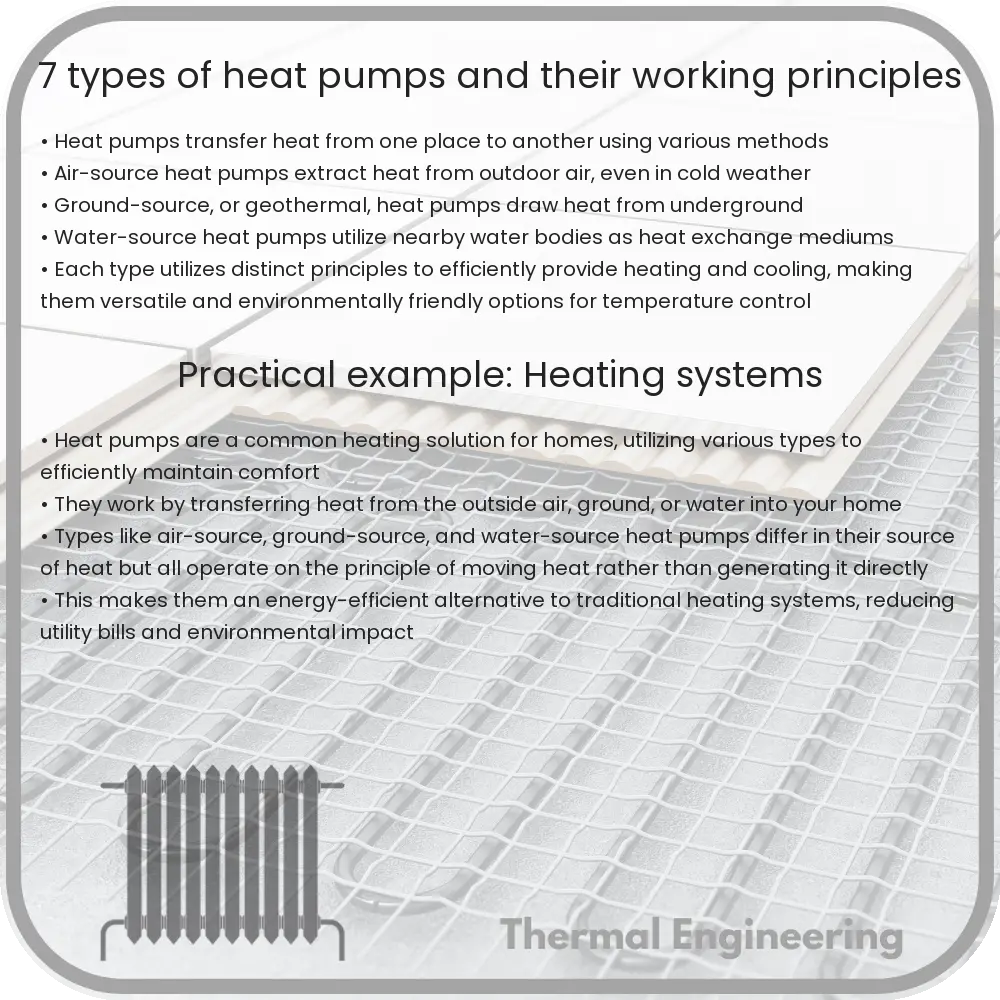Learn about the different types of heat pumps and how they work to efficiently heat and cool spaces using natural resources.

Understanding Heat Pumps: 7 Types and Their Working Principles
Heat pumps are devices that transfer heat from one place to another by using a small amount of energy. They are commonly used for both heating and cooling spaces as well as for heating water. Below, we explore seven common types of heat pumps and explain their working principles.
Air Source Heat Pumps (ASHPs)
Air source heat pumps are the most common type. They transfer heat between the air outside a building and the air inside through a refrigerant process. ASHPs absorb heat from the outdoor air in a coil that contains refrigerant. The refrigerant is compressed, which increases its temperature. It then goes through a condenser where the heat is released into the indoor air.
Ground Source Heat Pumps (GSHPs) or Geothermal Heat Pumps
Ground source heat pumps utilize the earth’s stable ground temperature to boost efficiency and reduce the operational costs of heating and cooling systems. These systems circulate a mixture of water and antifreeze through a loop of pipes buried underground. Heat is exchanged between the fluid in the pipes and the surrounding ground before being transferred to or from the indoor environment depending on the needs of space conditioning.
Water Source Heat Pumps (WSHPs)
Similar to GSHPs, water source heat pumps use water instead of the earth as the heat exchange medium. These systems are typically used in areas with a nearby water source such as a lake, pond, or well. The system’s pipes submerge in water, absorbing or dispersing heat through the water body.
Hybrid Heat Pumps
Hybrid heat pumps combine the features of air-source heat pumps with another type of heating system, typically a gas boiler. This allows them to maintain efficiency in colder climates where air-source heat pumps might struggle alone. The system automatically switches between the heat pump and the gas boiler depending on which is the most efficient at the given temperature.
Exhaust Air Heat Pumps
Exhaust air heat pumps extract heat from the exhaust air of a building and use it for heating fresh incoming air or water. These systems are particularly effective in tightly sealed properties where good ventilation is crucial. They help in maintaining energy efficiency by reusing the heat that would otherwise be expelled into the environment.
Absorption Heat Pumps
Absorption heat pumps are a variation of traditional heat pumps that use a heat source for their energy, often natural gas, solar-heated water, or geothermally heated water instead of electricity. Unlike other heat pumps, these use an absorbent fluid and a refrigerant, where the absorbent fluid absorbs and releases the refrigerant, which transports heat.
Solar-Assisted Heat Pumps
A solar-assisted heat pump incorporates solar thermal collectors, which capture and utilize solar energy to increase the efficiency of the heat pump. During sunny conditions, they use the collected solar energy to aid the heat pump, reducing the reliance on external electrical power or reducing the workload on the heat pump system.
Heat pumps are versatile and environmentally-friendly systems that offer both heating and cooling solutions. By leveraging natural sources and the laws of thermodynamics, they provide an energy-efficient alternative to traditional HVAC systems. Whether through air, water, ground, or solar assistance, these systems harness and transfer heat in a way that is not only ingenious but also beneficial for reducing carbon footprints and promoting sustainability.